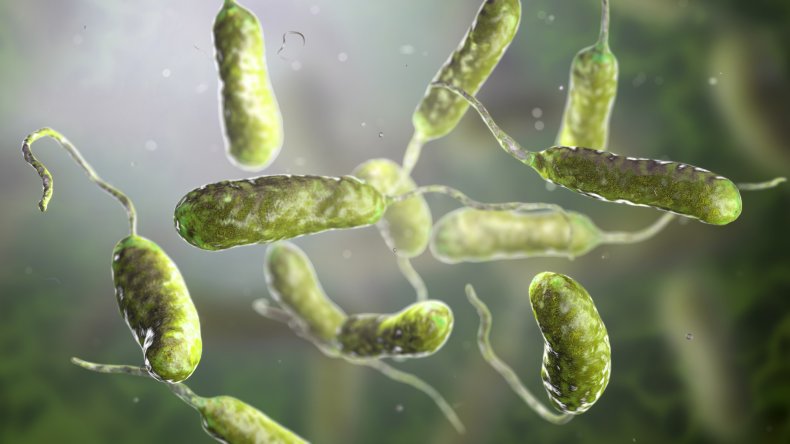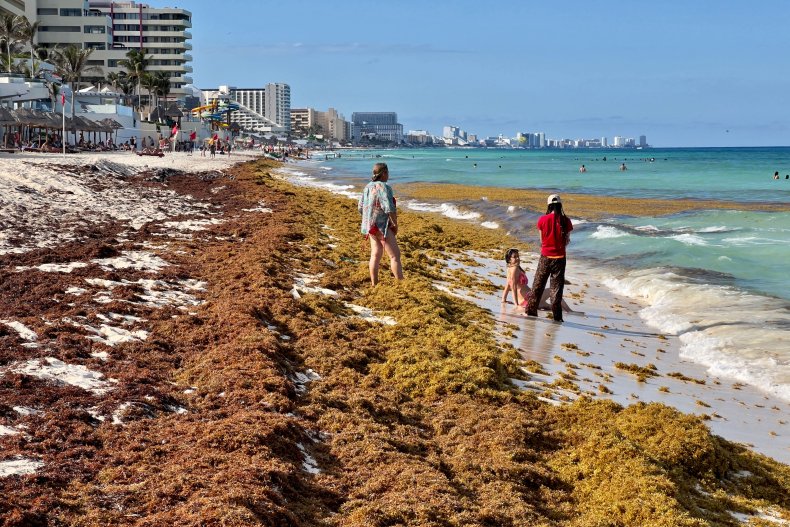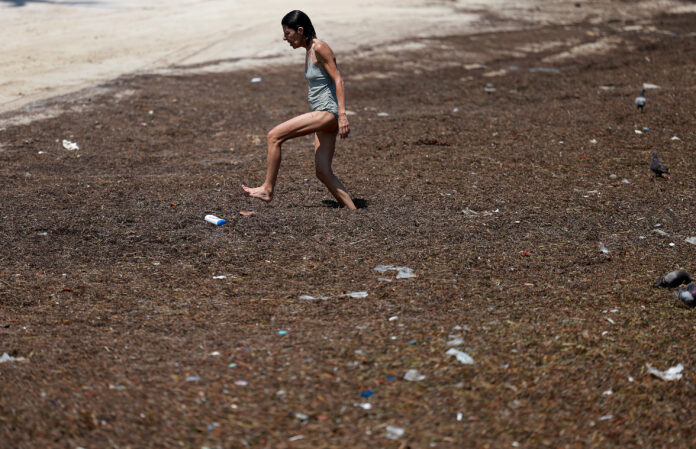The massive blob of seaweed creeping across the Atlantic Ocean toward Florida may contain deadly flesh-eating bacteria.
The 5,000-mile wide clump of seaweed is made up of sargassum seaweed, which has bloomed massively to form the “Great Atlantic Sargassum Belt.”
A study from Florida Atlantic University published in the journal Water Research found that the sargassum and its accompanying floating plastic can become inundated with species of Vibrio bacteria, creating a “perfect pathogen storm.”
The researchers found that beached sargassum seaweed is home to high levels of the bacteria and that the bacteria can readily cling to the surface of marine plastic debris, which accumulates in large volumes within the mass of seaweed.
Photo by Joe Raedle/Getty Images
Vibrio bacteria, notably the Vibrio vulnificus species, can lead to brutal infections and even necrotizing fasciitis, leading to the bacteria being nicknamed “flesh-eating.” Vibrio can infect via eating contaminated seafood, or through an open wound on someone’s flesh, usually from seawater, according to the Centers for Disease Control and Prevention. Infected wounds may become necrotic, with the flesh itself dying and rotting.
Around 1 in 5 people with the infection die, the CDC states, usually rapidly after becoming infected. Thankfully, necrotizing fasciitis is rare: only about 0.4 people per 100,000 are infected each year in the United States.

ISTOCK / GETTY IMAGES PLUS
“I don’t think at this point, anyone has really considered these microbes and their capability to cause infections,” Tracy Mincer, lead author of the Water Research paper and assistant professor of biology at FAU’s Harbor Branch Oceanographic Institute and Harriet L. Wilkes Honors College, said in a statement.
“We really want to make the public aware of these associated risks. In particular, caution should be exercised regarding the harvest and processing of Sargassum biomass until the risks are explored more thoroughly.”
The seaweed blob has only been growing: researchers at the University of South Florida’s Optical Oceanography Lab found that in March and April, the seaweed clump was estimated to contain about 13 million tons of sargassum, a record amount for that time of year.
The Vibrio bacteria may actually feed into the growth of the seaweed bloom, according to the Water Research paper.
“Another interesting thing we discovered is a set of genes called ‘zot’ genes, which causes leaky gut syndrome,” said Mincer. “For instance, if a fish eats a piece of plastic and gets infected by this Vibrio, which then results in a leaky gut and diarrhea, it’s going to release waste nutrients such nitrogen and phosphate that could stimulate Sargassum growth and other surrounding organisms.”

Photo by DANIEL SLIM/AFP via Getty Images
The seaweed has begun washing up on the beaches of Florida and Mexico over the past few months, as well as islands in the Caribbean, such as Guadeloupe. The huge volumes of seaweed have required a large amount of effort to remove in the past.
“The beaches are narrow and not very wide, so it just covers them up,” Stephen Leatherman, a professor of coastal science at Florida International University, previously told Newsweek. “It was so bad in Cancún a couple of years ago that 2,000 people in the Navy had to go out there with pitchforks and other means, just trying to clean it off the beach so they could see the sand.”
This may expose people clearing the beach to the Vibrio bacteria, risking infection via open wounds.
Other impacts of the seaweed include respiratory issues from the hydrogen sulfide released by the rotting seaweed.
“Anyone with compromised lung function should avoid areas with sargassum blooms—when the seaweed decomposes, it releases hydrogen sulfide [the smell of rotten eggs] and can be a respiratory irritant,” Kait Parker, an atmospheric scientist at the Weather Company, previously told Newsweek.
Hydrogen sulfide is a toxic gas that can cause respiratory problems and eye irritation, as well as acute sargassum toxicity in high doses, leading to convulsions, dizziness, headaches, weakness and nausea.
“Additionally, sargassum should not be consumed, as it contains heavy metals such as arsenic and cadmium. As for cleaning up—it’s best left to professionals. While the blooms aren’t harmful to touch, the microorganisms living on it can cause skin irritation,” Parker said.
Do you have an animal or nature story to share with Newsweek? Do you have a question about sargassum? Let us know via [email protected].


